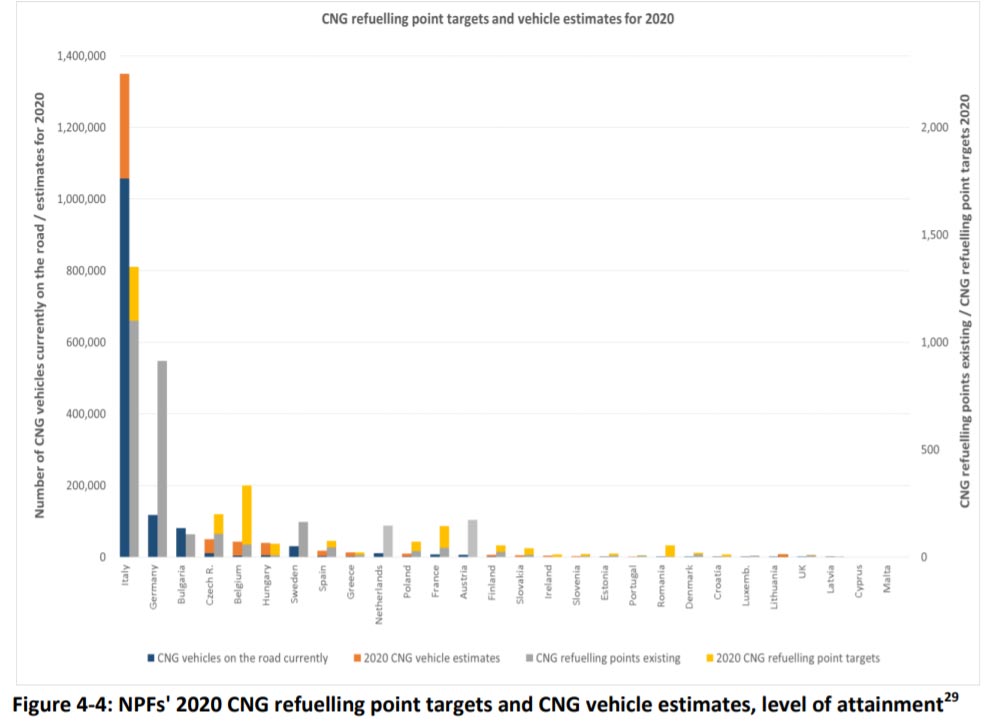Transportation plays a vital role in our daily lives. As we travel more and more distances, the carbon footprint of our transportation activities increases. Natural gas is a mature energy source and technology relay for the transport sector and the transition to a low-carbon society. It provides clean combustion and is based on a developed, affordable and competitive technology, and is therefore one of the solutions for low-carbon mobility.
The promotion of natural gas, in liquefied or compressed form, as an alternative source to conventional fuels has been included in the European Union's strategy on energy efficiency and the reduction of pollutant emissions, transposed by Directive 2014/94/EU of the European Parliament of 22 October 2014 on the deployment of alternative fuel infrastructure (AFI).
These objectives can boost the growing role of natural gas in both road and maritime transport. Natural gas is available as transportation solutions in the form of compressed natural gas (CNG) and liquefied natural gas (LNG). In the road sector, they can be used in small vehicles (CNG only), vans, buses or heavy goods vehicles (both CNG and LNG). LNG is also an alternative fuel for the shipping industry due to its lack of sulphur emissions.
Green Deal target for transport
Transport currently accounts for about a quarter of the EU's greenhouse gas emissions, according to official European Commission data, and the Green Deal aims to reduce this by 90% by 2050. The 2020 - 2030 timeframe brings new technology influences, but does not remove traditional fuels from the hydrocarbon list, meaning that a balanced mix in the future will ensure energy security and sustainable transportation. One of the sources promoted in the energy mix is natural gas, a clean source with efficient prospects for 2030-2050 in the context of decarbonization, being a fuel solution for a committed transition.
Natural gas vehicles emit up to 23% less CO2 than conventional cars. Due to their low impact on air quality in urban agglomerations, natural gas vehicles are mainly used in urban public transport. Emissions of SOx, NOx and carbon monoxide and particulate matter can also be significantly reduced by using natural gas vehicles.
The Natural & bio Gas Vehicle Association (NGVA Europe), an association that promotes the use of natural and renewable gas as a transportation fuel, points out that Natural gas also offers important synergies with biomethane from waste and biomass, or synthetic gas produced from wind or photovoltaic energy.
Decarbonizing road transport was initially expected through the use of biofuels and electrification. Recently, however, concerns about the sustainability of biofuels have limited their use. Natural gas used as a transportation fuel is a proven technology that is easy to use in conventional combustion engines, says Eurogas, in its study "The sustainable credentials of gas. A study of scenarios to 2050 by using PRIMES". For cars, which are generally used for short- and medium-distance travel, CNG has great potential, along with hybrid or electric engines. For heavy transport vehicles, which require a high energy density to transport their goods, electricity is not suitable, but natural gas can be used in the form of CNG or LNG, Eurogas adds.
CNG and LNG among EU-backed alternative fuels
The Alternative Fuels Infrastructure Directive (2014/94/EU) requires Member States to ensure a minimum infrastructure for alternative fuels such as electricity, hydrogen and natural gas. The development of the alternative fuels market has been held back by three main barriers, which have acted like a vicious circle: the high cost of vehicles, a low level of consumer acceptance, and a lack of refueling stations.
Thus, the directive has set a regulatory framework for CNG that requires Member States to ensure by the end of 2020 the installation of a sufficient number of publicly accessible refueling stations with common standards to allow the circulation of CNG vehicles in both urban and suburban areas and on the Trans-European Transport Network (TEN-T) core network. The directive recommends at least one charging point every 150 km by the end of 2025, but this is not a mandatory requirement.
On LNG, the European Commission states that Today's natural gas/biomethane vehicles offer well-developed technology with equivalent performance to conventional fuels. Thus, for the development of LNG in the road sector, the Directive requires Member States to ensure a sufficient number of public charging points with common standards on the TEN-T network. The directive recommends at least one charging point for every 400 km should be installed by the end of 2025, but the requirement is not mandatory. More details can be found in the European Commission document "Alternative Fuels. Member State Country Fiches".
At EU level, CNG technology has been underdeveloped, with the markets with the highest number of CNG vehicles on the road being Italy - by far the leader in this area, Germany and Bulgaria, according to another European Commission report, published in 2019.
Source: ec.europa.eu/transport/
Among the 27 Member States, Romania is only in 20th place, even though we are a country with large reserves of natural gas which could be used for this purpose. This sector has not developed locally, partly due to a lack of government support, which is currently directed only at electric vehicles. Public policy support for CNG technology and LNG as a transportation solution would bring numerous benefits for the local natural gas industry, consumers and the environment.






